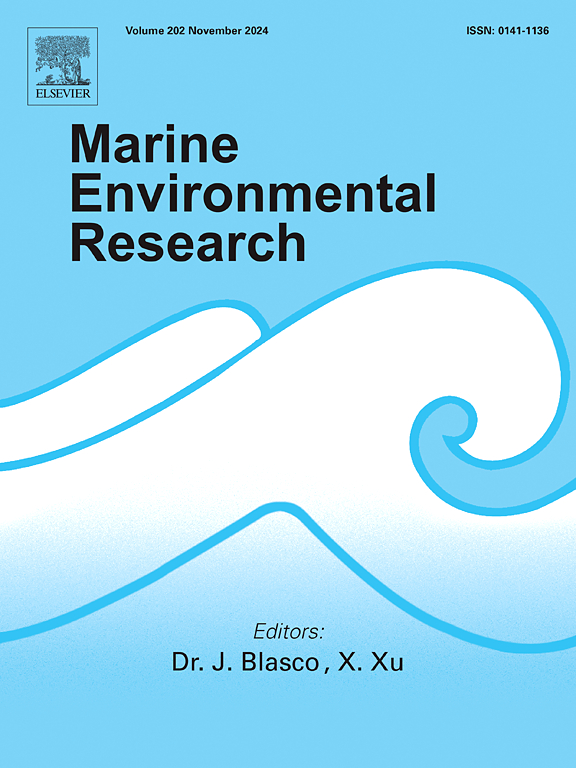鱼类养殖的大量碳输入降低了大型海藻养殖区的碳固存能力
IF 3.2
3区 环境科学与生态学
Q2 ENVIRONMENTAL SCIENCES
引用次数: 0
摘要
大型海藻海水养殖作为海洋二氧化碳去除(mCDR)战略得到推广,特别是在东亚。然而,实际上,大型藻类经常与鱼类和贝类共同培养,使碳预算复杂化,并可能改变净碳代谢。虽然大多数工作强调有机碳循环,但综合水产养殖对碳酸盐系统的响应仍未得到充分探索。在这项研究中,我们在世界上最大的海水养殖区之一三沙湾进行了季节性调查。与预期相反,海湾在冬季(海藻生长旺季)、春季和秋季持续释放二氧化碳。海面CO2分压(pCO2)达到500 ~ 1100 μatm,海气CO2通量为2.1 ~ 7.0 mmol m−2 d−1。在估计的200 μatm(强汇)的自然背景下,养殖的长期效果因营养组而异:海藻养殖降低了42±5 μatm,贝类养殖提高了36±4 μatm,鱼类养殖提高了375±18 μatm,将平均pCO2提高到~ 567±20 μatm,使系统从CO2汇转变为CO2源。在这个半封闭的海湾中,鱼类养殖产生的溶解无机碳(DIC)超过了藻类的吸收,推动了DIC和二氧化碳分压的增加,降低了该地区的碳固存能力。季节性海底地下水排放使pCO2增加~ 30 ~ 60 μatm,短期海水养殖活动可使pCO2偶尔升高至1100 μatm。三沙湾溶解无机碳稳定碳同位素(δ13CDIC)分析表明,三沙湾溶解无机碳和pCO2的季节性增加是由于春末残留海藻生物量的分解和秋季鱼饲料的有机物呼吸作用所致。为了实现最低限度保护和保护沿海环境,必须减少配方饲料的使用或开发替代的环境友好型养鱼方法。本文章由计算机程序翻译,如有差异,请以英文原文为准。
Massive carbon inputs from fish farming reduce carbon sequestration capacity in a macroalgae mariculture area
Macroalgae mariculture is promoted as a marine carbon dioxide removal (mCDR) strategy, particularly in East Asia. In practice, however, macroalgae is frequently co-cultured with fish and shellfish, complicating carbon budgets and potentially altering net carbon metabolism. While most work has emphasized organic carbon cycles, carbonate system responses under integrated aquaculture remain underexplored. In this study, we conducted seasonal surveys in Sansha Bay, one of the world’ largest mariculture zones. Contrary to expectation, the bay persistently outgassed CO2 during winter (the seaweed growth peak season), spring, and fall. Sea surface CO2 partial pressure (pCO2) reached 500–1100 μatm with air-sea CO2 fluxes of 2.1–7.0 mmol m−2 d−1. Against an estimated natural background of 200 μatm (a strong sink), long-term effects of cultivation diverged by trophic group: seaweed cultivation lowered pCO2 by 42 ± 5 μatm, shellfish farming increased it by 36 ± 4 μatm, and fish farming raised it by 375 ± 18 μatm, elevating mean pCO2 to ∼567 ± 20 μatm and transforming the system from a CO2 sink to a source. In this semi-enclosed bay, dissolved inorganic carbon (DIC) generated from fish farming overwhelms algal uptake, driving increases in DIC and pCO2 and reducing the region's carbon sequestration capacity. Seasonal submarine groundwater discharge added ∼30–60 μatm to pCO2, and short-term mariculture activities could episodically elevate pCO2 up to 1100 μatm. Analysis of the dissolved inorganic carbon stable carbon isotope (δ13CDIC) indicates that seasonal increases in DIC and pCO2 in Sansha Bay are due to the decomposition of residual seaweed biomass in late spring and organic matter respiration from fish feed in fall. To achieve mCDR and protect coastal environments, it is essential to reduce formulated feed use or develop alternative environmentally friendly fish farming methods.
求助全文
通过发布文献求助,成功后即可免费获取论文全文。
去求助
来源期刊

Marine environmental research
环境科学-毒理学
CiteScore
5.90
自引率
3.00%
发文量
217
审稿时长
46 days
期刊介绍:
Marine Environmental Research publishes original research papers on chemical, physical, and biological interactions in the oceans and coastal waters. The journal serves as a forum for new information on biology, chemistry, and toxicology and syntheses that advance understanding of marine environmental processes.
Submission of multidisciplinary studies is encouraged. Studies that utilize experimental approaches to clarify the roles of anthropogenic and natural causes of changes in marine ecosystems are especially welcome, as are those studies that represent new developments of a theoretical or conceptual aspect of marine science. All papers published in this journal are reviewed by qualified peers prior to acceptance and publication. Examples of topics considered to be appropriate for the journal include, but are not limited to, the following:
– The extent, persistence, and consequences of change and the recovery from such change in natural marine systems
– The biochemical, physiological, and ecological consequences of contaminants to marine organisms and ecosystems
– The biogeochemistry of naturally occurring and anthropogenic substances
– Models that describe and predict the above processes
– Monitoring studies, to the extent that their results provide new information on functional processes
– Methodological papers describing improved quantitative techniques for the marine sciences.
 求助内容:
求助内容: 应助结果提醒方式:
应助结果提醒方式:


